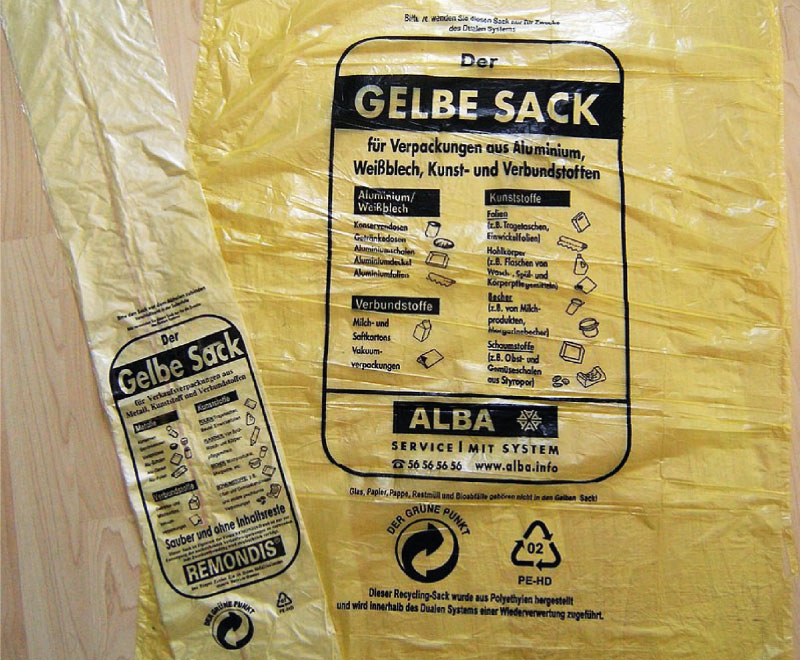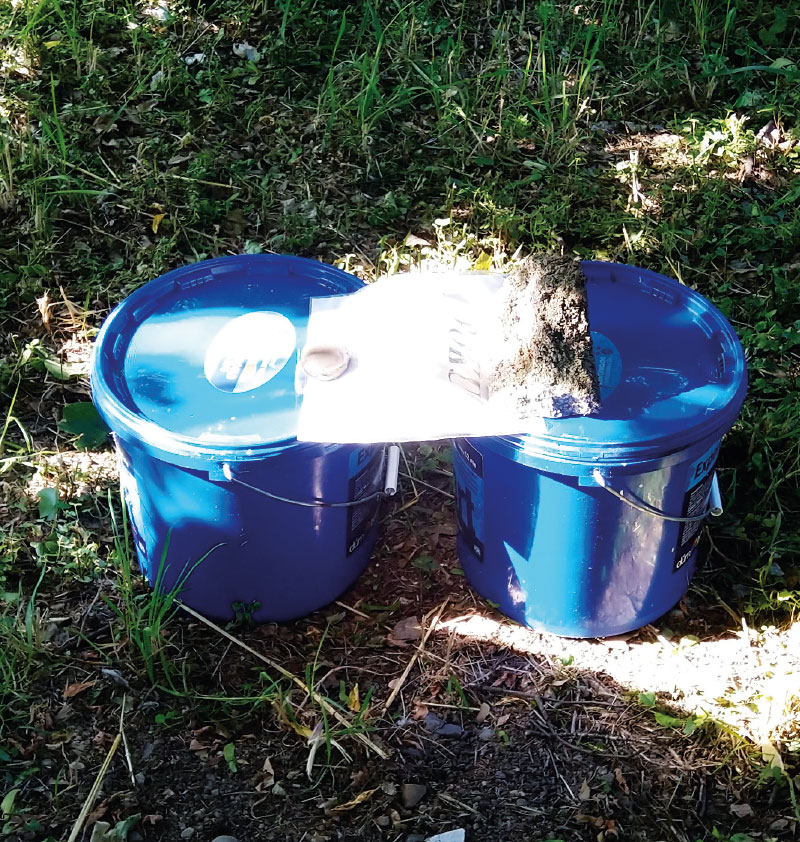ABSTRACT
The ever-increasing amount of waste, including biological waste, is causing serious problems in modern society, such as the filling of municipal waste landfills, which subsequently produce greenhouse gases. For society to deal with this problem, the legislation of some member states of the European Union (EU), including the Czech Republic (CR), has introduced new obligations to support the prevention of waste generation and its increased recycling and reuse. In 2020, the European Commission released the Circular Economy Action Plan, which provides guidelines for many countries on renewables and waste. However, in some cases the current measures are not enough. A new law on waste was adopted in the Czech Republic, which specifies the obligation to sort biological waste for legal entities and natural persons who allow physical persons to dispose of municipal waste in their establishments.
This article brings the current interim results of research project SS02030008 “Centre of Environmental Research: Waste Management, Circular Economy and Environmental Security (CEVOOH)”. It deals with a brief description of biodegradable municipal waste (BMW) collection in some EU countries and draws general conclusions from the facts found. It also deals with the current results of measuring the moisture loss of biological waste in order to fulfil the obligation of the Czech Republic to report the quantity of this waste in its “fresh” state.
INTRODUCTION
Methods of collection and management of biodegradable municipal waste (BMW) are of great importance (not only) in the EU from the point of view of environmental protection and sustainable waste management. Biodegradable waste (BW) includes organic waste such as food scraps, garden waste, leaves, coffee grounds, and other organic materials that can be naturally broken down by microorganisms. The prevention, effective separation, and collection of such waste are key to reducing the amount of waste that ends up in landfills, while representing an important step towards sustainable waste management.
The legislation that governs the issue of biological waste in the EU and the Czech Republic includes several standards that represent a framework for Member States and set goals and limits for waste collection and management.
Key ones include:
- EU Landfill Directive – Article 5 sets the amount of BMW that Member States can place in landfills in individual years (in percentages). At present, according to the Directive, the maximum amount of BMW deposited in landfills in 2020 should be no more than 35 % of the weight of the total amount of BMW produced in 1995. This target is also set by the Czech Republic in the current Waste Management Plan of the Czech Republic.
- EU Landfill Directive – Article 3a generally stipulates the obligation that from 2030 no waste suitable for recycling or other use, in particular municipal waste, is accepted into landfill, with the exception of waste for which landfilling leads to the best environmental outcome in accordance with Article 4 of Directive 2008/98/EC.
- EU Waste Framework Directive – Article 22 establishes the obligation to introduce measures by 31 December 2023 at the latest to ensure that biological waste is either sorted and recycled at source, or that it is subject to sorted collection and is not mixed with other types of waste.
- At the national level, there is already a ban on the storage of BW and outputs from its modification or processing, namely in Section 41 paragraph 3 letter b), with the exception of waste with a minority share of biodegradable components, or outputs from the treatment or processing of BW, which cannot be processed in any other way.
- In point D of Annex No. 4 to Decree No. 273/2021 Coll., on the details of waste management, the requirements are set for BW with a minority share of biodegradable components and outputs from their treatment which can be deposited in a landfill.
One of the fundamental obligations that will affect the sorting of biowaste in municipalities is the obligation of municipalities in the following years to forward an increasingly higher percentage of usable components of municipal waste for recycling (60 % from 2025, 65 % from 2030, and 70 % from 2035). Fulfilment of this obligation will also be conditional on ensuring the sorting of a sufficient amount of biowaste.
However, there is a considerable difference between individual EU states in the area of BW collection and management.
A total of 199,558 links were found in the Web of Science database during the analysis of publications on methods of sorting and collecting BW in municipalities. As can be seen in Fig. 1, publication activity is increasing at a gradual pace, depending on the approaching deadlines of the restriction set by the adopted EU legislation.
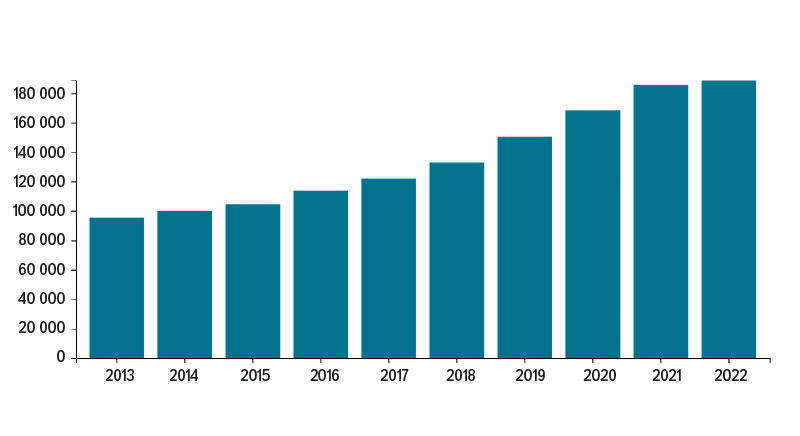
Fig. 1. Graph of publication activity in the Web of Science database (Source: database Web of Science)
Fig. 2 shows the distribution of the countries with the greatest publication activity. The European countries are represented by England, Italy, Germany, France (in descending order).
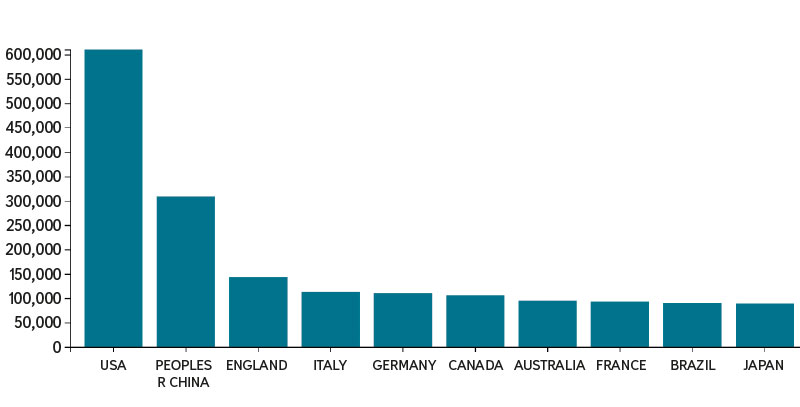
Fig. 2. Graph of the publication activity of the most important countries in the Web of Science database (Source: database Web of Science)
A search of the professional literature shows that countries that have been relying on separate systems for the collection and processing of biological waste for more than 15 years include, for example, Austria, Switzerland, Germany, the Netherlands, Flanders (Belgium), Sweden, and Norway. These countries have well-developed infrastructure and legislative frameworks that support the sorting and composting of biowaste [1].
Summary of biowaste collection and management methods in selected European countries
Specific and (from our point of view) key aspects of successfully preventing the creation, sorting, and processing of BW (including food waste), and thereby fulfilling the principles of the circular economy, differ in individual EU countries (Tab. 1).
Tab. 1. Food waste production by sector of activities, 2020 (tonnes of fresh mass; numbers in italics are estimates). (Source: https://1url.cz/ruEEQ)
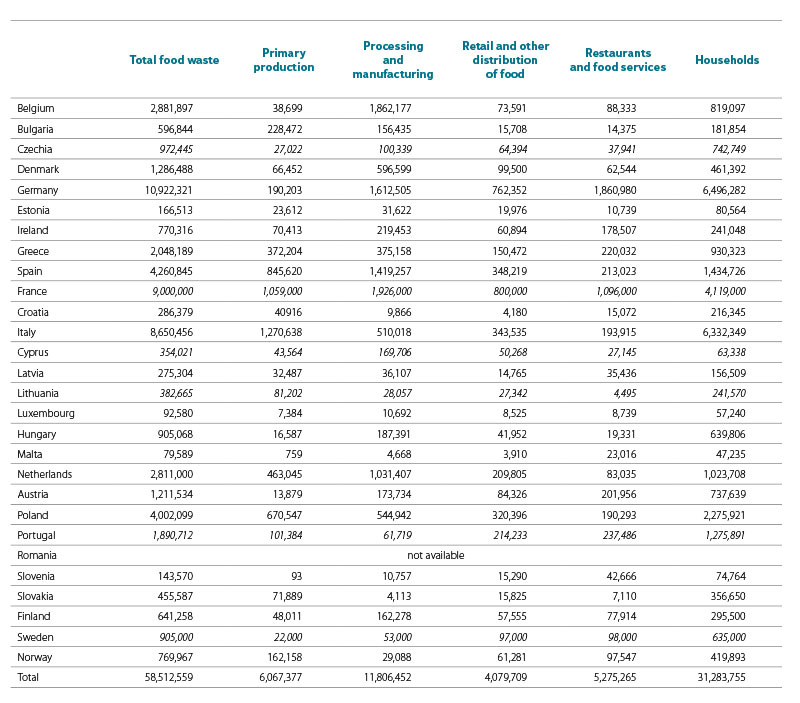
The following summary describes some collection methods and motivating residents to fulfil their obligations in selected European countries:
AUSTRIA
Austria has a developed biowaste collection system with approximately 70 % coverage of the population. Austrians throw away a fifth of all the food they buy, of which the loss of 14.5 %, which amounts to one billion Euros per year, is partially or completely avoidable [2]. Austrian consumers are responsible for almost half of the total waste, while agricultural production is responsible for around 30 % of total food waste. Farmers, producers, retailers, and food service operators (e.g., hotels, restaurants, caterers) in Austria either produce too much food that never reaches consumers, or food losses arise from inefficient storage, transport, or planning the demand [3] .
Food losses and waste are never local – fluctuations are caused by market prices of food and contribute to global carbon dioxide emissions. Countries like Austria, with developed infrastructure and available economic and social resources, are pioneers in creating solutions to the issue of systematic food waste. In Austria, biowaste collection is developed and integrated into the overall waste management system. Citizens have at their disposal special collection containers for biowaste, which are placed in municipalities and in public spaces, regularly emptied, and their contents processed by composting. The motivation for residents is mainly high awareness and education about the importance of sorting and recycling waste, which leads to a high level of involvement. The waste is collected separately from normal municipal waste and subsequently processed using methods such as composting and anaerobic digestion [4].
SWITZERLAND
Switzerland may have a reputation as one of the cleanest countries in the world, but with more than 90 million tons of waste produced annually (700 kg per person), it is one of the world’s largest producers of waste. At the same time, however, thanks to the adopted waste management policy, it is one of the countries with the highest efficiency of its recycling programme. More precisely, the country achieves a recycling rate of up to 50 %; the remaining waste is further used to generate energy by incineration. Switzerland has a long tradition of waste sorting and BW forms an important part of the system, with composting being a common method of processing this waste [5]. We can consider the following aspects leading to such results:
- Prevention – influencing consumer behaviour; consumers-waste producers are informed not only about the positive aspects of the right way of shopping and timely consumption of food, but are also familiar with the fee they will pay in the case of generated waste.
- Intervention – support consumers in recycling. Part of the intervention plan is an active effort to (a) make recycling infrastructures accessible and easy to use by the population and (b) enable citizens, with proper sorting, to dispose of waste for free, i.e., use of private/community composters/compost plants.
- Consumer education – transfer of final responsibility to the producer according to the principle “The cost of waste disposal is borne by the person who produces it”. This principle is implemented by taxing the amount of waste produced by each individual. In addition, only official bags provided by the authorities can be used for the disposal and collection of municipal waste. These are available in different sizes and price per litre of content
(e.g., €0.033/litre in Bellinzona).
Authorities are responsible for monitoring and sanctioning any illegal disposal of waste. The same applies to littering or leaving small amounts of litter in public places. This activity is prohibited and punished by the authorities. Although “legal punishment” has a deterrent effect, real change in consumer behaviour can only be achieved through proper education. Raising awareness is essential in solving a social issue such as littering. In particular, depending on the target age, different strategies can be implemented, such as education – at an early stage in public schools, later through public campaigns [6].
We can say that although Switzerland has a solid foundation and has implemented a successful waste management strategy, it continues to focus on intervention at the source of the problem, i.e., waste prevention, which remains a key area to be addressed in the future. The Swiss experience shows that a more informed citizen does not automatically mean a more informed and engaged consumer, which is why educational campaigns to promote sustainable consumption are constantly organized there. For truly effective efforts, they recommend focusing on both sides of the market, i.e., the “consumer” and the “producer”. The Swiss government is trying to take measures at the regulatory level and penalize those who produce products that contribute the most to waste generation (e.g., products with a particularly short shelf life or excessive packaging) [7].
GERMANY
Every year, around 15 million tons of BW are processed in composting and fermentation or biogas plants in Germany. In essence, it is the contents of organic waste bins, BW from gardens and parks, waste from markets, and other BW from various sources. In some regions of Germany, the “Gelber Sack” approach is applied, which is a system where different types of waste are packed in special yellow bags and collected regularly (Fig. 3). A significant incentive for residents is the system of refunding fees for returning packaging, which stimulates proper waste sorting. In 2020, about 5 million tons of organic waste and about 5.7 million tons of garden and park waste were separately collected via organic waste bins in Germany, which corresponds to 129 kilograms per inhabitant per year. Germany is known for its advanced and carefully organized waste sorting system. Here, BW is also collected separately in green or brown containers and is subsequently used for composting or anaerobic digestion [8–10].
Fig. 3. Yellow bags „Gelber Sack“ used in Germany (Source: https://de.wikipedia.org/wiki/Gelber_Sack#)
THE NETHERLANDS
The Netherlands places great emphasis on waste recycling. BW is collected and processed in order to minimize its impact on the environment. In 2018, for example, 56 % of all municipal waste was recycled, and since then this number has been constantly increasing [11]. In the Netherlands, the “gescheiden afvalinzameling” system (separate waste collection) is often used. Citizens have separate collection containers for biowaste at their disposal, which are regularly emptied. The country invests in awareness and education campaigns, which helps increase awareness and involvement in waste sorting. It considers composting to be key BW (food) processing, which takes place in most municipalities. Food is sorted and stored in green containers (groenbak), which are collected regularly, or residents are directly motivated to buy composting containers for food and to use compost, even in cities on balconies and terraces.
FLANDERS (BELGIUM)
The total amount of food waste produced in all sectors of the food chain in Flanders amounts to almost 1.3 million tonnes per year, of which 71 % is collected separately and 29 % is part of mixed waste. The highest production of food waste comes from the food industry (122 kg/capita), which is important in Flanders – 55 % of food produced in Flanders is intended for export. Households produce 61 kg/capita, which is below the EU average (70 kg/capita) [12–14]. Flanders is a region in Belgium with a very advanced waste sorting system; separate collection of BW is mandatory. Citizens have access to biowaste containers that are regularly emptied and composted. An important part of success is the active involvement of local communities and municipalities, which promote sorting and talk about the benefits of recycling. Biodegradable waste is collected separately and processed exclusively for the purpose of producing compost.
SWEDEN
Although Sweden produces an average of 467 kg of waste per person and almost 4.4 million tons of household waste per year, the key to the country’s success is high public awareness of the benefits of recycling, as well as an efficient collection system. The process starts with households and businesses sorting waste into hazardous and recyclable materials, separating food waste, metal, plastic, paper and glass packaging, newspapers, electronics, tyres, and batteries. To encourage everyone to join the system, Sweden has built waste collection points within 300 metres of all residential areas. While some of this waste is recycled, almost half of the waste produced (typically a mix of energy-rich
materials such as paper, plastic, and biomass) is taken to waste-to-energy facilities, where it is converted into electricity. Similarly, food waste is turned into climate-friendly biogas used to run public transport buses and heat apartment buildings.
Key aspects of promoting sorting and recycling in Sweden are:
- Household awareness of the importance and benefits of sorting waste
In the vast majority of Swedish households, waste is sorted at its source. The awareness and dedication of the citizens of Sweden is a key success factor that has led to Sweden being considered one of the global leaders in sustainable waste management. Most households in Sweden sort their waste into the following fractions: food waste, metal, plastic, paper and glass packaging, newspapers, electronics, tyres, and batteries. Important steps are currently being taken to increase the reuse and repair of goods. Extended producer responsibility creates incentives to reduce waste production and increase material recycling. - Converting waste to energy
A large part of the waste generated in Sweden is incinerated in facilities intended for its energy use in the field of water district heating, as well as electricity generation. As a result of all the measures taken, less than one percent of the total amount of waste produced in the country is landfilled. Urban planning is an important tool when municipalities want to work on waste management according to the required hierarchy. - Waste management in Swedish legislation
The legal basis for the Swedish waste management system is laid down by both Swedish and European waste legislation. In Sweden, landfilling is the least preferred solution. The preferred option is to prevent waste and reuse and repair products. If waste is still generated, the main goal is to recycle the materials. Sweden is one of the leading EU countries in BW management. Local sorting and collection systems support recycling and biogas production [15–17].
NORWAY
Norway, like other Nordic countries, has effective BW collection and processing systems, with composting and anaerobic digestion being common methods. Norway is an example of using BW as an energy source. There are a number of anaerobic fermentation facilities in the country that process gastro-waste and the resulting biogas is used as a renewable energy source [18, 19].
ITALY
In Italy, the sorting and collection of BW is regulated regionally and may vary from municipality to municipality. Some have a system of bio-waste bins, while others promote composting in households and public places [20, 21].
FRANCE
In some parts of France, BW collection is well organized, while in other areas there is room for improvement. Some cities collect food waste using special containers. The activities of start-ups and civic associations play an important role here [22–27].
SYNTHESIS
From the above, the following key aspects necessary to ensure the fulfilment of obligations in BW sorting follow. Specifically, they are:
- Information campaigns: most countries organize information campaigns and educational activities that explain the importance of sorting and proper BW management.
- Financial incentives and penalties: some countries use financial incentives through a system of waste charges. Citizens who sort well may have lower fees. Conversely, if the waste is sorted incorrectly, penalties and fines may be imposed.
- Quality infrastructure: countries with good infrastructure, including accessible dustbins and collection containers, make it easier for citizens to sort properly.
- Support for composting: some countries support home composting and provide citizens with composters for free or at reduced prices.
All EU countries, including the Czech Republic, are obliged to sort biodegradable components of municipal waste by the end of 2023. This obligation applies to municipalities and towns, which must achieve a minimum level of sorting that supports the use of waste and the reduction of landfill.
Production of individual components of biowaste differs depending on whether it comes from family homes or housing estates. In housing estates, green waste is generated in limited quantities, while kitchen waste predominates. Seasonality also has an impact – green waste production increases during the warm months, while kitchen waste production remains stable throughout the year.
Currently, together with BW from the urban greenery and garden maintenance, it is possible to collect plant components of kitchen and food waste from households. Biowaste collection systems are focused on all plant components, but above all on the green component, which makes up only about a third of the total biowaste collected. Kitchen waste does not have its own collection system, although the Ministry of the Environment sets the obligation to collect at least the plant component. It is important to plan the collection system to include all components of biowaste, including kitchen waste.
A key aspect is the purity of biowaste, which plays a vital role in its processing. Regardless of whether the waste is intended for processing in a composting plant or a biogas station, the purity of the collected material is key. In order to ensure purity, it is important to prevent pollution from sorted biowaste through education of residents and limiting access to biowaste containers, for example by locking them. Sorting technologies exist, but they are expensive. In the Czech Republic, the sorting of most biowaste in composting plants is carried out in a not very sophisticated way; therefore, during the growing season, a large amount of biowaste can accumulate in composting plants, which is not effectively sorted.
Waste sorting systems are key to preventing contamination of biowaste with pollutants. EU Member States may waive the obligation of separate collection of biowaste in certain cases, for example in inner city areas where the logistics of separate collection may be difficult, or in sparsely populated rural areas. In these cases, alternative biowaste processing methods such as domestic, local, or community composting can be supported.
Some countries, including the UK, Italy, Finland, Ireland, Slovenia, Estonia, and France, have made significant progress in developing their biowaste collection and processing systems in recent years. On the other hand, some countries, including the Czech Republic, still need to improve their infrastructure and implement effective measures and legislation to meet EU requirements regarding biowaste sorting [28–30].
Factors affecting the efficiency of the set biowaste collection system
The method of sorting BW, including waste from urban greenery maintenance, gardens, and food waste, is of key importance for the sustainable processing of this waste and environmental protection. From the above research, there are several factors that influence the success and efficiency of separate BW collection. These factors include:
- Motivating, communicating, and educating residents
Motivation, communication and education of residents are key to a successful BW collection system. The methods of their implementation include:- Personal communication, campaigns, workshops, and training that are organized for citizens to inform them about the importance and correct way of sorting and collecting biowaste.
- Instructions and educational materials that help citizens sort waste correctly.
- Financial incentives, such as discounts on waste fees or rewards for correct sorting, which could motivate citizens to actively participate.
- Punishment, i.e., sanctions or fines for those who do not comply with waste sorting obligations, and can serve as additional motivation to fulfil obligations in this area.
- Collection convenience
- Delivery distance for which the principle applies – the closer the collection containers are located to households, the more probably people will actively use them. A longer distance may reduce willingness to participate in sorting.
- Collection hygiene, i.e., ensuring the cleanliness of collection containers and their regular maintenance, which is important for minimizing odours and the occurrence of harmful microorganisms and other pests.
- Cleanliness of collection containers and prevention of the spread of odours and development of mould; the odour from BW can be unpleasant, especially in the summer months. It can also cause problems with insects. Resolving these issues is important for acceptance of waste collection.
- The influence of temperature, which determines the rate of decomposition of biological waste. In colder areas, decomposition may be slower, which may require more care when collecting. When choosing the location of collection containers, places that are shaded for most of the day should be preferred.
- Frequency of waste removal
Frequent and regular emptying of collection containers minimizes odours and prevents the accumulation of waste, which leads to more convenient sorting for residents. Regular removal of BW is important for maintaining the cleanliness and hygiene of the collection points. Insufficient removal frequency can lead to over-filled containers and problems with insect. People are more motivated to sort if they are sure that their waste is collected regularly. - Method of collection
Outdoor vs. indoor waste bins: the provision of indoor collection containers can increase the convenience of sorting, especially in adverse weather conditions. In some cases, it may be appropriate to place containers indoors to minimize odour and aesthetic issues. However, outdoor containers are usually easier to access.
Vented vs. non-vented waste bins: vented containers can minimize the development of unpleasant odours and mould.
Waste bin size: the optimal size of collection containers ensures sufficient capacity while minimizing the long-term accumulation of waste that could lead to problems. - Method of home composting
Composting bins: offering composting bins allows residents to do their own composting, reducing the amount of BW that would have to be removed. Providing compost bins to households can motivate people to sort BW more actively. These containers placed, for example, in gardens or on balconies allow easier composting.
Community composters: The establishment of community composters provides the possibility of sorting waste even for those who do not have enough space for their own composting. These composters can be placed publicly in different parts of the city. This increases accessibility for a wider spectrum of the population.
Overall, we can say that the sorted collection of BW requires attention to details such as the location of collection containers, cleanliness, hygiene, and waste removal. It is also important to consider different collection methods, such as outdoor and indoor containers, as well as supporting alternative methods, such as community composters, which can increase the involvement and motivation of residents to actively sort waste.
Effect of temperature and container ventilation on moisture loss of biodegradable municipal waste
To ensure the fulfilment of the Czech Republic’s obligation regarding the notification of the occurrence of food waste, a requirement was established to report the amount of this waste in its “fresh” state. During the research survey that we carried out as part of the SS02030008 project “Centre of Environmental Research: Waste Management, Circular Economy and Environmental Security (CEVOOH)”, we obtained data from reports of the Slovak Ministry of the Environment regarding the collection of BMW. In order to verify their applicability for the Czech Republic, our project included a requirement to determine moisture loss during food waste storage in model conditions that correspond to common practice.
Since sorted food waste is normally collected at intervals of one to two weeks, we carried out two cycles of experiments, each lasting 14 days. Experiments were performed both with perforated and non-perforated containers, and the composition of food waste was consistent with what we found in previous analyses of mixed municipal waste, BMW and food waste [31]. Specifically, the food mix consisted of: fruits and vegetables 39 %; pastries, pasta, dumplings 24 %; meat, eggs including shells 6 %; dairy products 9 %; cooked meals 19 %, and beverages 3 %.
12-litre containers with lids were used to simulate the usual method of sorting and collection and, at the same time, to minimize the amount of spoiled food (Fig. 4).
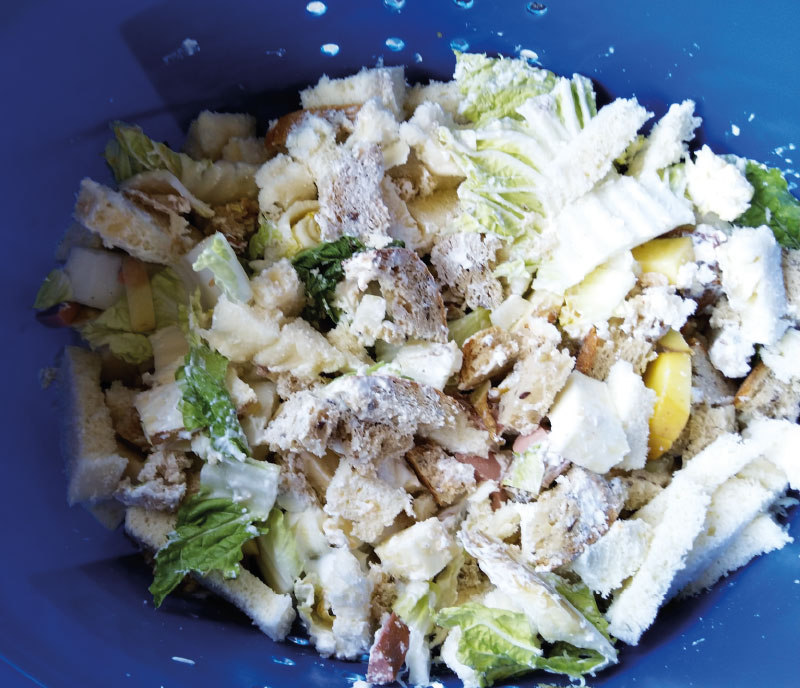
Fig. 4. Food mixture at the beginning of the experiment and a perforated container with a lid at the experimental site (Source: TGM WRI)
The containers were stored in a place partially protected by trees from the sun and rain (Fig. 5).
Fig. 5. Placement of test container (Source: TGM WRI)
The first measurement took place in April and the second in June. Fig. 6 shows the course of BMW weight reduction under the stated measured minimum (average 5.1 °C) and maximum (average 13 °C) temperatures together with the measured air humidity (average 73.2 %) during the April experiment. Weight or the moisture content of the food waste in the perforated container decreased by 350 g within 14 days, or 7.5 % by weight compared to a non-perforated container with a BMW weight loss of only 50 g, i.e., 1.1 % of weight.
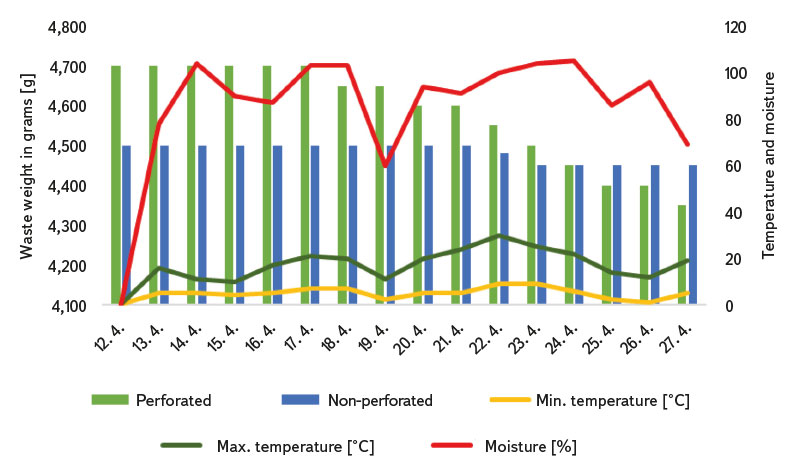
Fig. 6. Graph of moisture loss or weight of BMW during the April measurement (Source: TGM WRI)
In June, we repeated the measurements under the same conditions to find out the effect of temperatures on weight loss, or moisture. During the June measurement, when the minimum temperatures reached an average of 13.7 °C and the maximum 25.7 °C, the largest decrease in weight (moisture) occurred again in the perforated container, by 8.7 % (Fig. 7).
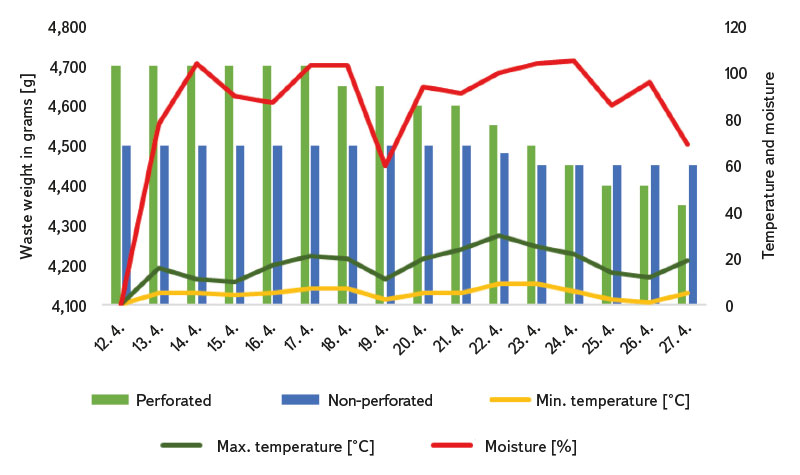
Fig. 7. Graph of moisture loss or weight of BMW during the June measurement (Source: TGM WRI)
During the June measurement, fungi and animals (ants, slugs, flies) had a significant influence on the decomposition of matter, and thus also on the loss of weight compared to the April measurement. For comparison, Fig. 8 shows the appearance of the measured sample at the end of the 14-day measurement in April (left) and June (right).
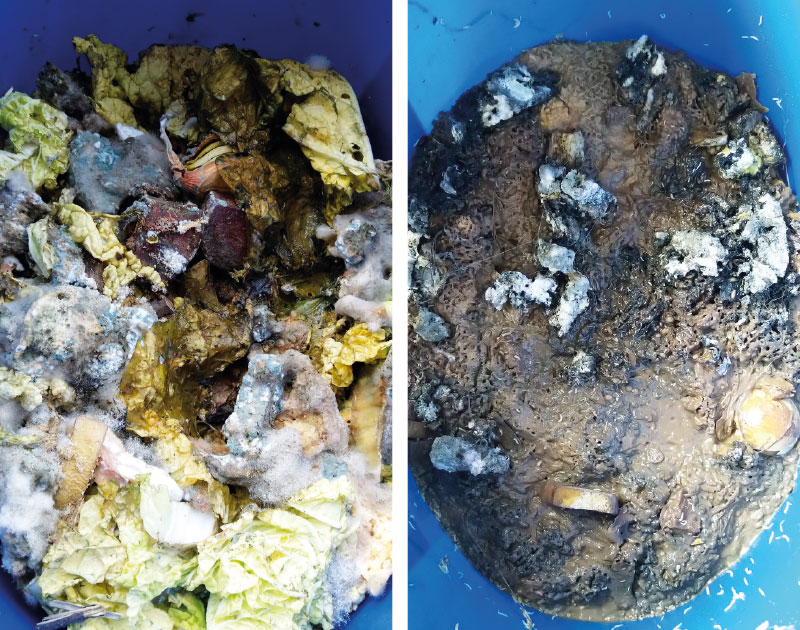
Fig. 8. Appearance of measured samples in perforated containers at the end of the measurement in April (left) and June (right) (Source: TGM WRI)
Based on the measured data on moisture loss, a uniform coefficient of 0.09 was determined, which will be included in the methodology “Measurement of the amount and composition analysis of food waste” as a correction factor for calculating the total amount of municipal food waste. After approval, its final version will be published on the project website [32] at the end of this year.
CONCLUSION
The issue of determining production and preventing the creation of food waste is currently a topic of project SS02030008 “Centre of Environmental Research: Waste Management, Circular Economy and Environmental Security (CEVOOH)”, within the framework of which, and in close cooperation with the MoE, we are preparing a methodology for measuring the weight of food waste. The analysis of approaches to solving the issue of BMW and food waste in selected EU countries shows us a number of different approaches that can be a suitable inspiration for dealing with the issue of prevention and effective management of this type of waste in the Czech Republic. The data and knowledge base of the food waste issue has currently been supplemented by the BMW moisture loss analysis, which is just under 10 % of the weight of the analysed waste and will be part of the newly prepared methodology.
Acknowledgements
The article was supported by the project SS02030008 “Centre of Environmental Research: Waste Management, Circular Economy and Environmental Security (CEVOOH)”, which is co-financed by the Technology Agency of the Czech Republic as part of the Environment for Life Programme.
This article was translated on basis of Czech peer-reviewed original by Environmental Translation Ltd.
